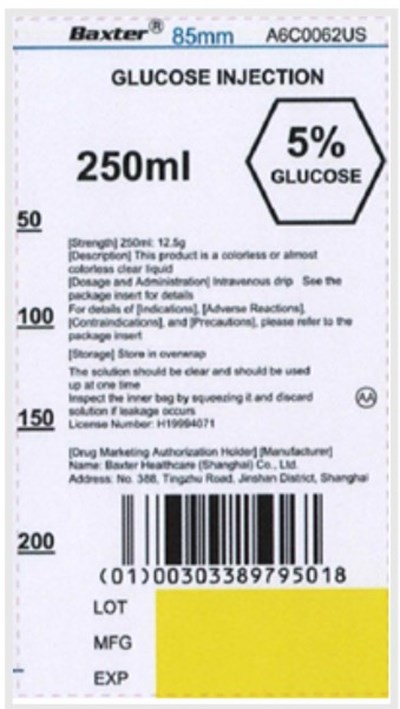Product Images Glucose
View Photos of Packaging, Labels & Appearance
- DHCP Letter 2.jpg - imag 02
- DHCP Letter 1.jpg - image 01
- DHCP Letter 3.jpg - image 03
- DHCP Letter 4.jpg - image 04
- DHCP Letter 5.jpg - image 05
- DHCP Letter 6.jpg - image 06
- DHCP Letter 7.jpg - image 07
- DHCP Letter 8.jpg - image 08
- DHCP Letter 9.jpg - image 09
- DHCP Letter 10.jpg - image 10
- DHCP Letter 11.jpg - image 11
- SPC302US Image 1.jpg - image 12
- SPC302US Image 2.jpg - image 13
- SPC302US Image 3.jpg - image 14
- SPC302US Image 4.jpg - image 15
- SPC305US Image 1.jpg - image 16
- SPC305US Image 2.jpg - image 17
- SPC305US Image 3.jpg - image 18
- SPC305US Image 4.jpg - image 19
- A6C0062US Representative Carton Label.jpg - image 20
- A6C0062US Representative Carton Label 2.jpg - image 21
- A6C0064US Representative Carton Label 1 - image 22
- A6C0064US Representative Carton Label 2.jpg - image 23
Product Label Images
The following 23 images provide visual information about the product associated with Glucose NDC 0338-9801 by Baxter Healthcare Corporation, such as packaging, labeling, and the appearance of the drug itself. This resource could be helpful for medical professionals, pharmacists, and patients seeking to verify medication information and ensure they have the correct product.
DHCP Letter 2.jpg - imag 02
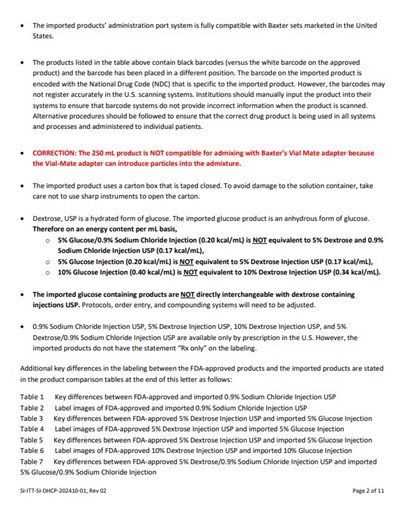
The text provides information about imported medical products and highlights differences between them and similar products approved in the United States. It discusses issues such as barcodes, compatibility with certain adapters, packaging, product content, and the need for adjustments in protocols and systems when using the imported products. It also includes details on the differences in labeling and provides tables for easy comparison of the products. Overall, the text serves as a guide for healthcare professionals on how to handle and use these imported medical products effectively and safely.*
DHCP Letter 1.jpg - image 01
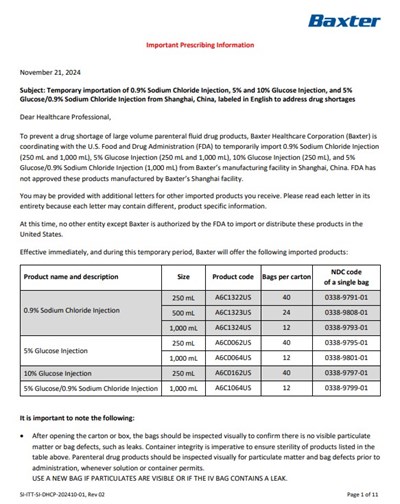
The text provides information regarding the temporary importation of various medical products by Baxter Healthcare Corporation to address drug shortages, in coordination with the U.S. Food and Drug Administration (FDA). The imported products include 0.9% Sodium Chloride Injection, 5% and 10% Glucose Injection, and a combination product. It specifies the sizes and product codes for each item. The text emphasizes the importance of visually inspecting the bags for particulate matter or defects before administration to ensure product sterility and safety. This communication aims to inform healthcare professionals about the temporary availability of these products and the necessary precautions to be taken during their use.*
DHCP Letter 3.jpg - image 03

This text provides information on reporting adverse events or product quality issues related to FDA-approved and imported 5% dextrose/0.9% sodium chloride injection products. It includes contact details for reporting issues, how to submit adverse event reports to the FDA, and instructions for reporting product quality issues. Additionally, it mentions resources for prescribing information for various glucose and sodium chloride injection products. Contact information for Baxter's Medical Information Service and Center for Service is also provided for further assistance and orders.*
DHCP Letter 4.jpg - image 04
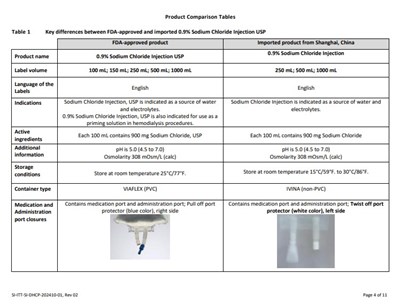
This description is a detailed comparison between an FDA-approved 0.9% Sodium Chloride Injection USP product and an imported product from Shanghai, China. The document highlights key differences such as label volumes, language of indications, active ingredients, additional information, storage conditions, and container types. It also compares the medication and administration features including port closures. This comparison is useful for understanding the differences between the two products in terms of specifications and usage instructions.*
DHCP Letter 5.jpg - image 05

This is a label for FDA-approved and imported 0.9% Sodium Chloride Injection USP. The label features details about the imported product from Shanghai, China, as well as information about the product's labeling color and barcode details. The label includes the brand name Baxter and specifies the product as Sodium Chloride Injection with 1000 mL volume. It indicates the presence of the NDC number and linear barcode with human-readable information.*
DHCP Letter 6.jpg - image 06

This is a comparison table showing key differences between the FDA-approved 5% Dextrose Injection USP and imported 5% Glucose Injection. The comparison includes details such as product names, label volumes, language of indications, active ingredients, osmolarity, caloric content, storage conditions, container types, and medication administration port closures. The table provides valuable information for individuals looking to understand the distinctions between these two products.*
DHCP Letter 7.jpg - image 07

The text provides a comparison between FDA-approved 5% Dextrose Injection USP and imported Glucose Injection products. It lists the label color as black and mentions that the imported product is from Shanghai, China. The FDA-approved product is from Baxter. The labels for both products show 1000 mL as a representative quantity. The imported product contains an NDC number, and the barcode location is shown. The labels also include textual information in addition to the barcode.*
DHCP Letter 8.jpg - image 08
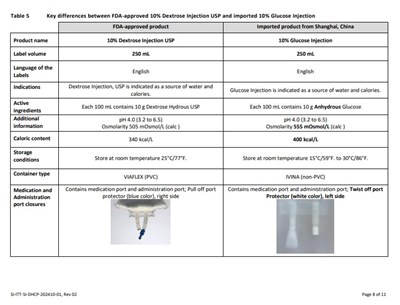
This is a comparison between FDA-approved 10% Dextrose Injection USP and imported 10% Glucose Injection from Shanghai, China. The FDA-approved product is labeled as 10% Dextrose Injection USP with a volume of 250mL, while the imported product is labeled as 10% Glucose Injection with the same volume. The active ingredients are slightly different, with the FDA-approved product containing 10 Dextrose Hydrous USP and the imported product containing 108 Anhydrous Glucose per 100mL. Other differences include osmolarity, caloric content, storage temperature, container type, and the color of administration protectors and port closures.*
DHCP Letter 10.jpg - image 10

Table 7 shows key differences between FDA-approved 5% Dextrose/0.9% Sodium Chloride Injection USP and imported 5% Glucose/0.9% Sodium Chloride Injection. The FDA-approved product is labeled for 1000mL volume, in English, and indicated for fluid/electrolyte replenishment and caloric supply. It contains 5g Dextrose Hydrous USP and 900 mg Sodium Chloride USP per 100mL. The Osmolarity is 560 mOsmol/L. It is stored at 25°C/77°F in a PVC container with specific administration port closures. The imported product from Shanghai, China is labeled for 100mL volume, in English, indicated for similar uses, and contains Anhydrous Glucose and 500 mg Sodium Chloride per 100mL. The Osmolarity is 585 mOsmol/L. It is stored at 15°C/59°F to 30°C/86°F in a non-PVC container with different administration port closures.*
SPC302US Image 1.jpg - image 12

This is the package insert for a Glucose Injection product. It provides details on the drug name, ingredients, dosage, administration instructions, indications for use, and precautions. The insert emphasizes the importance of following physician directions carefully while using this product. It also highlights considerations for patients with specific conditions such as hypoglycemia and ketoacidosis. The text outlines the potential risks associated with incorrect administration, including hyperosmolarity, dehydration, and electrolyte disturbances. Overall, this information serves as a guide for healthcare professionals to ensure safe and effective use of Glucose Injection.*
SPC302US Image 4.jpg - image 15
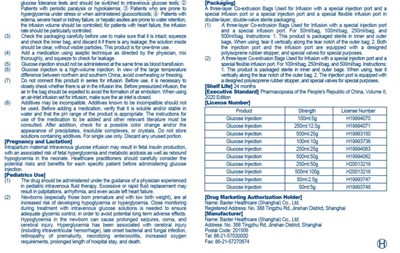
This text appears to be a set of instructions and precautions related to the usage of glucose injections in the medical field, particularly focusing on pediatric use. It emphasizes the importance of proper handling of the product before use and highlights potential risks and considerations when administering glucose injections to patients, including infants. The document also mentions the possible adverse effects and complications that may arise from incorrect usage of glucose injections. Additionally, it provides details regarding the equipment and specifications related to the administration of glucose injections.*
SPC305US Image 1.jpg - image 16

This description provides information about Baxter Glucose Injection, including its approval date, revision dates, chemical composition, indications for use (such as energy source or fluid replacement), strengths available, potential contraindications (such as allergies or specific medical conditions like hyperglycemic nonketotic hyperosmolar state or uncontrolled diabetic ketoacidosis), and adverse reactions that may occur in patients. It also emphasizes the importance of reading the package insert carefully and using it under the direction of a physician.*
SPC305US Image 2.jpg - image 17
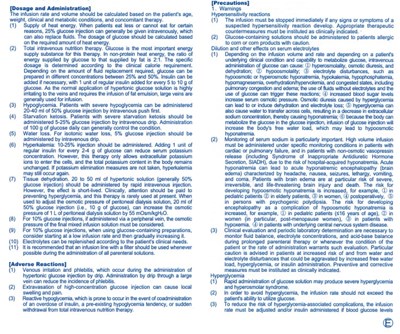
This text provides detailed guidelines on the calculation and administration of fluids and glucose therapy for patients based on various conditions such as weight, clinical and metabolic conditions, and concurrent therapy. It covers aspects like energy supply, total intravenous nutrition therapy, hypoglycemia, starvation ketosis, water loss, electrolyte replenishment, tissue dehydration, warnings, contraindications, and monitoring considerations. The text also highlights the importance of using caution and monitoring serum levels particularly in patients with cardiac or pulmonary failure, and those with nonosmolar vasopressin release. It emphasizes the risks associated with specific conditions like hyponatremia, encephalopathy, and the importance of fluid balance and electrolyte management to prevent complications.*
SPC305US Image 3.jpg - image 18

Baxter glucose injection guidelines: Considerations and precautions. This document outlines the administration of intravenous glucose in various patient scenarios such as impaired glucose tolerance, diabetic conditions, severe malnutrition, alcoholism, chronic illnesses, and trauma. Special caution advised for stroke patients, undernourished individuals, newborns, and patients with electrolyte disturbances. Overdosage warnings, interactions with medications affecting glycemic levels, and electrolyte balance are also highlighted. Special instructions for infusion and monitoring are detailed to prevent complications like refeeding syndrome. It is advised to understand the potential interactions and risks when using glucose injection for patients with specific medical conditions to ensure safe administration.*
SPC305US Image 4.jpg - image 19

This is a detailed text providing instructions and precautions for the use of glucose injections in medical settings. It covers important information such as administration guidelines for different patient groups like pediatrics and pregnant women, storage recommendations, packaging details, pharmacokinetics, shelf life, executive standards, license numbers, drug marketing authorization holder, and manufacturer contact information. The text emphasizes safety measures and proper handling of the product to ensure its effectiveness and the well-being of patients.*
A6C0062US Representative Carton Label 2.jpg - image 21

This text provides information on 5% Glucose Injection with LOT number, expiry date, and manufacturing details. The product comes in 250ml packaging. LOT numbers and expiry dates are specified, but the specific manufacturing date and license numbers are provided.*
A6C0064US Representative Carton Label 2.jpg - image 23
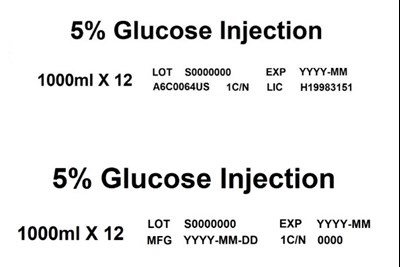
This text describes a 5% Glucose Injection product available in 1000 mL packaging. It provides information on the lot number, expiry date, manufacturing date, and the quantity of packages. The details on the packaging suggest multiple units being available for purchase.*
* The product label images have been analyzed using a combination of traditional computing and machine learning techniques. It should be noted that the descriptions provided may not be entirely accurate as they are experimental in nature. Use the information in this page at your own discretion and risk.




